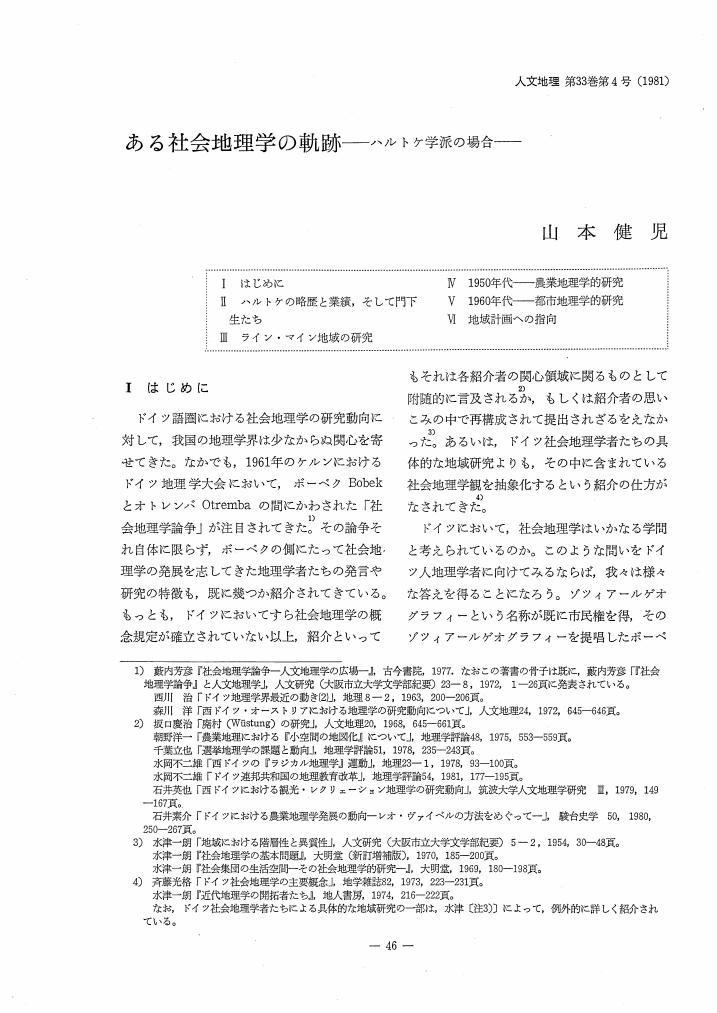1 0 0 0 ある社会地理学の軌跡:ハルトケ学派の場合
1 0 0 0 OA ミュンヘンにおける「ガストアルバイター」住民の空間的セグリゲーション
- 著者
- 山本 健児
- 出版者
- 一般社団法人 人文地理学会
- 雑誌
- 人文地理 (ISSN:00187216)
- 巻号頁・発行日
- vol.32, no.3, pp.214-237, 1980-06-28 (Released:2009-04-28)
- 参考文献数
- 65
- 被引用文献数
- 6 3
The spatial segregation of the “Gastarbeiter population” (foreign workers and their families from the countries around the Mediterranean) has become one of the current social issues in West Germany since 1973. In response to the social significance of this phenomenon various investigations have been made. But little research has given attention to problems such as the formation of the spatial segregation, its possible developments and the consequent changes in urban spatial form.The purpose of the present paper is to describe the spatial form of segregation of the “Gastarbeiter population” in Munich and its changes, and to explain the phenomena by means of examination of the social processes involved.The concept of spatial segregation is defined as an unequal distribution of a group in relation to one group over given area. In order to show its spatial form, the author adopted a method of calculating the residential location quotient for each national group in each Munich ward and mapping its results. These are computed as follows:residential location quotient=ai/bi/A/B×100where ai is population of a group A in a ward i, A is the total population of a group A in Munich, bi is the total population in a ward i, and B is the total population in Munich.The results are shown in the figures 2-13. The spatial form of segregation of foreigners in total in the year 1969 is characterized by concentration in the Munich periphery as well as in the inner city. In the year 1978 they were concentrated only in the latter.Although each “Gastarbeiter population” displayed a peculiar spatial form of segregation by nationality, we can point out that they evidenced more or less similar characteristics not only in their distribution but also in their mobility. But Austrians who do not belong to the “Gastarbeiter population” showed a different tendency. Already in 1971, they were concentrated almost exclusively in the inner city; since then they have dispersed more and more all over the municipal area of Munich.The spatial form of and its change in segregation of the “Gastarbeiter population” mentioned above came about through the housing conditions available to them. There are two channels of housing for them: accommodation by employers and the private housing market. Accommodation facilities which are provided by employers are usually located in or near a factory site. In the process of economic growth, factories came to be located on the periphery of Munich, so that the concentration of the “Gastarbeiter population” was marked there around 1970. Immediately after the Gastarbeiter are recruited through the Bundesanstalt für Arbeit (Federal Labour Office), they live first in the company dormitory. Because of the recession the recruiting of new Gastarbeiter has been suspended since. November 1973. On the other hand, the physical and social conditions in the company dormitories are not good, so that the Gastarbeiter tend to move out of them. Thus the importance of dormitories as housing for Gastarbeiter became reduced.On the contrary the private housing market has come to play a more and more important role, especially since the Gastarbeiter must have recourse to it when they are joined by their families. Because of their lower wage and desire to save as much money as possible they demand dwellings of low-rent housing, which is concentrated in the inner city as Figure 14 shows. But it does not mean that the “Gastarbeiter population” have gotten dwellings of lower rent in a real sense. They are forced to pay higher rent than German tenants for dwellings of equal conditions (Table 5).
1 0 0 0 OA ある社会地理学の軌跡
- 著者
- 山本 健児
- 出版者
- 一般社団法人 人文地理学会
- 雑誌
- 人文地理 (ISSN:00187216)
- 巻号頁・発行日
- vol.33, no.4, pp.334-351, 1981-08-28 (Released:2009-04-28)
- 参考文献数
- 102
- 被引用文献数
- 2 1
1 0 0 0 OA グローバル化時代における公共空間と場所アイデンティティの再編に関する研究
- 著者
- 高木 彰彦 遠城 明雄 荒山 正彦 島津 俊之 中島 弘二 山野 正彦 源 昌久 山本 健児 熊谷 圭知 水内 俊雄 久武 哲也 山野 正彦 源 昌久 山本 健兒 熊谷 圭知 水内 俊雄 内田 忠賢 堤 研二 山崎 孝史 大城 直樹 福田 珠己 今里 悟之 加藤 政洋 神田 孝治 野澤 秀樹 森 正人 柴田 陽一
- 出版者
- 九州大学
- 雑誌
- 基盤研究(B)
- 巻号頁・発行日
- 2006
公共空間と場所アイデンティティの再編について、地理思想史、理論的研究、経験的研究の観点から検討を行った。研究成果として、『空間・社会・地理思想』10(2006)、『空間・社会・地理思想』11(2007)、『空間・社会・地理思想』12(2008)を毎年刊行したほか、英文報告書として『Reorganization of public spaces and identity of place in the time of globalization : Japanese contribution to the history of geographical thought(10)』(2009)を刊行した。
